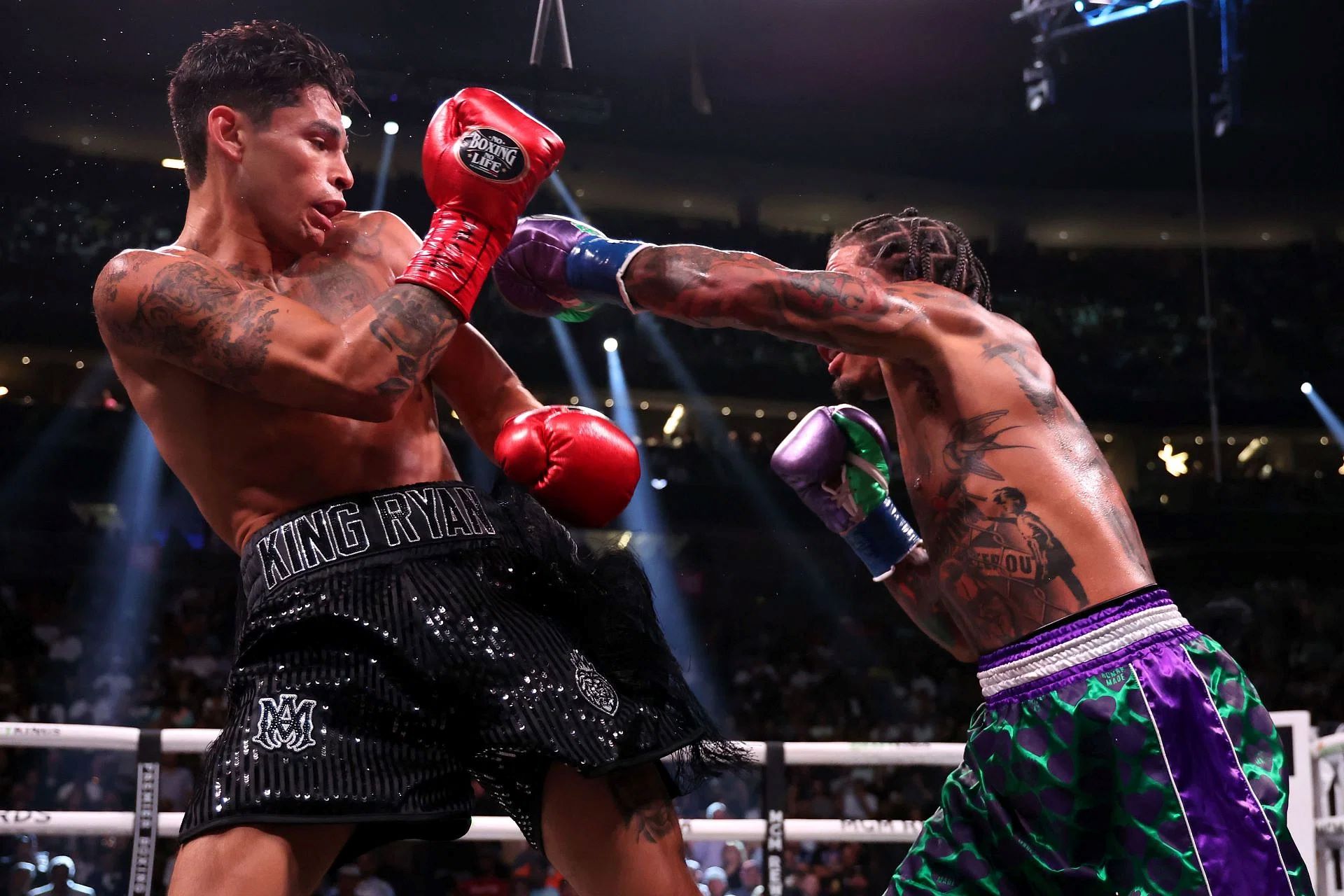Home>Sports>The Secret Boxing Rule You Never Knew: Rehydration Clause Explained


Sports
The Secret Boxing Rule You Never Knew: Rehydration Clause Explained
Published: January 20, 2024
Discover the hidden rehydration clause in boxing and its impact on sports. Uncover the secret rule that changes the game for athletes. Gain insights into the rehydration clause and its significance in sports.
(Many of the links in this article redirect to a specific reviewed product. Your purchase of these products through affiliate links helps to generate commission for Regretless.com, at no extra cost. Learn more)
Table of Contents
Introduction
Boxing is a sport that has captivated audiences for centuries, with its blend of raw athleticism, strategy, and sheer courage. The sweet science, as it's often called, is a sport where every detail can make a difference in the outcome of a match. While most fans are familiar with the basic rules and regulations that govern boxing matches, there is one lesser-known, yet crucial, rule that has a significant impact on the sport – the rehydration clause.
This little-known rule has been a hot topic of discussion among boxing aficionados and insiders, yet it remains a mystery to many casual fans. The rehydration clause plays a pivotal role in shaping the dynamics of a boxing match, influencing the physical condition and performance of the fighters in ways that are often overlooked. Understanding the intricacies of this rule provides a deeper insight into the sport and sheds light on the measures taken to ensure fair competition and fighter safety.
In the following sections, we will delve into the details of the rehydration clause, exploring its purpose, mechanics, and implications within the realm of professional boxing. By unraveling this secret rule, we aim to provide a comprehensive understanding of its significance and the controversies it has sparked within the sport. Join us as we unravel the mystery behind the rehydration clause and gain a newfound appreciation for the complexities that shape the world of boxing.
What is the Rehydration Clause?
The rehydration clause, also known as the hydration clause, is a stipulation that is often included in the contracts for professional boxing matches. This clause is designed to regulate the weight at which fighters compete on the day of the bout, specifically during the weigh-in and the subsequent weigh-in on the day of the fight. While the primary focus of traditional weigh-ins is to ensure that fighters meet the specified weight limit for their respective weight classes, the rehydration clause extends this oversight to monitor the amount of weight that a fighter is allowed to regain after the initial weigh-in.
In essence, the rehydration clause aims to prevent extreme weight cutting practices among fighters, which can have detrimental effects on their health and safety. Weight cutting, a common practice in combat sports, involves fighters drastically reducing their body weight in the days leading up to the weigh-in, often through methods such as severe dehydration and excessive exercise. This temporary weight loss allows fighters to qualify for lower weight classes, where they may have a size and strength advantage over their opponents.
However, the rapid rehydration and weight regain that typically follow extreme weight cutting can pose serious risks to the fighters' well-being. Rehydrating too quickly can lead to electrolyte imbalances and compromised physical performance, increasing the likelihood of injuries and health complications during the actual fight. The rehydration clause seeks to address these concerns by imposing restrictions on the amount of weight that fighters are permitted to regain after the initial weigh-in, thereby discouraging extreme weight cutting practices and promoting safer weight management strategies.
By limiting the extent of rehydration, the rehydration clause aims to level the playing field and mitigate the potential advantages gained through extreme weight cutting. It serves as a safeguard to protect the fighters' health and ensure a fair and competitive environment within the sport of boxing. While the implementation of the rehydration clause has sparked debates and controversies within the boxing community, its underlying purpose remains rooted in prioritizing the well-being and integrity of the athletes who step into the ring.
In the next section, we will delve into the mechanics of how the rehydration clause operates and its implications for boxing matches.
How Does the Rehydration Clause Work?
The rehydration clause operates by imposing specific limitations on the amount of weight that fighters are allowed to regain after the initial weigh-in, typically conducted a day before the actual fight. This restriction is enforced to prevent fighters from engaging in extreme weight cutting practices, which can have detrimental effects on their health and competitive performance.
Upon the initial weigh-in, fighters must comply with the designated weight limit for their respective weight classes, adhering to the standard regulations that govern boxing competitions. However, the implementation of the rehydration clause introduces an additional dimension to the weigh-in process. In many cases, fighters are required to undergo a secondary weigh-in on the day of the fight, typically a few hours before they enter the ring.
During this second weigh-in, fighters are subject to the stipulations outlined in the rehydration clause, which dictate the maximum amount of weight they are permitted to regain after the initial weigh-in. This restriction serves as a safeguard against rapid and excessive rehydration, mitigating the potential risks associated with drastic weight fluctuations within a short timeframe.
The specifics of the rehydration clause can vary depending on the contractual agreements between the fighters, their respective management teams, and the organizing bodies overseeing the match. The allowable weight gain following the initial weigh-in is typically expressed as a percentage of the fighter's weigh-in weight, with the exact percentage determined by the terms outlined in the contract.
For instance, a rehydration clause might stipulate that a fighter cannot exceed a certain percentage of their weigh-in weight when they step on the scale for the secondary weigh-in on the day of the fight. This restriction aims to discourage extreme weight cutting tactics and promote healthier weight management practices among fighters.
By regulating the rehydration process, the rehydration clause aims to create a more level playing field by minimizing the potential advantages gained through extreme weight manipulation. Additionally, it serves to prioritize the safety and well-being of the fighters, reducing the likelihood of dehydration-related complications and promoting more sustainable approaches to weight management within the sport of boxing.
In the subsequent section, we will explore the impact of the rehydration clause on boxing matches and the dynamics of fighter performance.
Impact on Boxing Matches
The rehydration clause wields a profound impact on the dynamics of boxing matches, exerting influence on the physical condition, performance, and strategic considerations of the fighters. By regulating the process of weight regain leading up to the fight, the rehydration clause introduces a set of implications that reverberate throughout the ring.
Leveling the Playing Field
One of the primary impacts of the rehydration clause is its role in leveling the playing field among fighters. By curbing the extent of weight regain permitted after the initial weigh-in, the clause aims to mitigate the potential advantages gained through extreme weight cutting practices. This limitation encourages fighters to compete closer to their natural weight, reducing the likelihood of significant size and strength differentials between opponents. As a result, the emphasis shifts towards skill, technique, and conditioning, promoting a more equitable competitive environment within the sport.
Fighter Performance and Endurance
The rehydration clause directly influences the physical readiness and endurance of the fighters. By imposing restrictions on rapid weight regain, the clause aims to deter the detrimental effects of dehydration and excessive rehydration on the fighters' bodies. This, in turn, can impact their overall performance and stamina during the fight. Fighters who previously relied on drastic weight cutting to gain a size advantage may find themselves competing at a weight closer to their natural state, potentially altering their physical capabilities and endurance levels. Consequently, the rehydration clause has the potential to reshape the dynamics of in-ring confrontations, placing a greater emphasis on sustained performance and skill rather than temporary physical advantages.
Strategic Considerations
The implementation of the rehydration clause introduces strategic considerations for fighters and their coaching teams. With limitations on weight regain, fighters need to adopt more calculated approaches to weight management and conditioning leading up to the fight. This may entail a shift in training regimens, dietary plans, and overall preparation strategies to ensure that fighters can perform optimally within the confines of the rehydration restrictions. Moreover, the clause may influence tactical decisions regarding fighting style and pacing, as fighters adapt to the altered physical parameters resulting from the regulated weight regain process.
Fighter Safety and Well-being
Beyond its impact on the competitive aspects of boxing matches, the rehydration clause plays a pivotal role in prioritizing the safety and well-being of the fighters. By discouraging extreme weight cutting and rapid rehydration, the clause aims to reduce the potential health risks associated with drastic weight fluctuations. This emphasis on fighter safety aligns with broader efforts within the sport to promote responsible weight management practices and mitigate the adverse effects of extreme weight cutting on the athletes' long-term health.
In essence, the rehydration clause permeates the fabric of boxing matches, influencing the competitive landscape, fighter performance, strategic considerations, and the overarching commitment to fighter safety. Its impact extends beyond the confines of the ring, shaping the ethos of the sport and underscoring the multifaceted considerations that govern professional boxing.
Controversies Surrounding the Rehydration Clause
The implementation of the rehydration clause has not been without its share of controversies within the realm of professional boxing. While the clause aims to address concerns related to extreme weight cutting and promote safer weight management practices, it has sparked debates and divided opinions among fighters, promoters, and fans alike.
One of the primary points of contention revolves around the perceived impact of the rehydration clause on fighter performance and competitive dynamics. Critics argue that the limitations imposed by the clause can potentially diminish the spectacle and excitement of certain matchups. Fighters who previously relied on extreme weight cutting to gain a significant size and strength advantage may find themselves competing at a weight closer to their natural state, potentially altering the dynamics of their in-ring confrontations. This shift has led to concerns about the potential reduction in knockout power and the overall spectacle of certain matchups, as fighters compete under more regulated weight conditions.
Additionally, the rehydration clause has faced scrutiny regarding its potential influence on promotional considerations and the marketability of fights. Some stakeholders within the boxing industry have expressed concerns about the impact of the clause on the marketability of matchups, particularly those that were previously characterized by significant size differentials between the fighters. The regulated weight regain process has prompted discussions about the potential alteration of traditional weight class dynamics and the implications for the appeal of certain fights to the broader audience.
Moreover, the practical implementation and enforcement of the rehydration clause have been subject to scrutiny, with questions raised about the consistency and fairness of its application across different boxing events. There have been instances where the interpretation and execution of the clause have led to contentious situations, sparking debates about its efficacy and potential unintended consequences.
Despite the controversies surrounding the rehydration clause, proponents argue that its underlying purpose of prioritizing fighter safety and well-being remains paramount. Advocates emphasize the importance of mitigating the risks associated with extreme weight cutting and promoting a more equitable and sustainable competitive environment within the sport. They contend that the clause serves as a safeguard to protect the long-term health and integrity of the athletes, aligning with broader efforts to foster responsible practices in professional boxing.
The controversies surrounding the rehydration clause underscore the nuanced considerations and divergent perspectives that shape the ongoing discourse within the sport. As the boxing community continues to navigate the implications of this rule, it remains a focal point of discussion, reflecting the evolving landscape of professional boxing and the multifaceted factors that influence its trajectory.
Conclusion
In the realm of professional boxing, the rehydration clause stands as a clandestine yet pivotal rule that permeates the dynamics of the sport. Through its regulation of weight regain and the prevention of extreme weight cutting practices, the clause seeks to foster a more equitable, competitive landscape while prioritizing the safety and well-being of the fighters. Its impact extends beyond the confines of the ring, influencing the strategic considerations, fighter performance, and the overarching ethos of the sport.
While controversies have arisen regarding its potential influence on fighter performance and the marketability of matchups, the underlying intent of the rehydration clause remains rooted in safeguarding the long-term health of the athletes. By discouraging drastic weight fluctuations and promoting responsible weight management, the clause aligns with broader efforts to uphold the integrity and safety of professional boxing.
As the sport continues to evolve, the rehydration clause serves as a reflection of the multifaceted considerations and divergent perspectives that shape the discourse within the boxing community. Its implementation prompts ongoing discussions about its implications for competitive dynamics, fighter safety, and the broader appeal of boxing events. The nuanced debates surrounding the clause underscore the evolving landscape of professional boxing and the ongoing efforts to strike a balance between competitive fairness and fighter well-being.
In unraveling the mystery behind the rehydration clause, we gain a deeper appreciation for the intricate measures taken to uphold the integrity and safety of professional boxing. While its impact may spark debates and controversies, the underlying commitment to prioritizing the welfare of the fighters underscores the enduring values that define the sport. As the sport continues to navigate the complexities of its regulatory framework, the rehydration clause remains a testament to the ongoing pursuit of a balanced, competitive environment that places the well-being of the athletes at the forefront.
The rehydration clause, shrouded in secrecy yet profound in its implications, stands as a testament to the multifaceted considerations that govern the world of professional boxing, underscoring the enduring commitment to fostering a sport that embodies both competitiveness and responsible practices.













